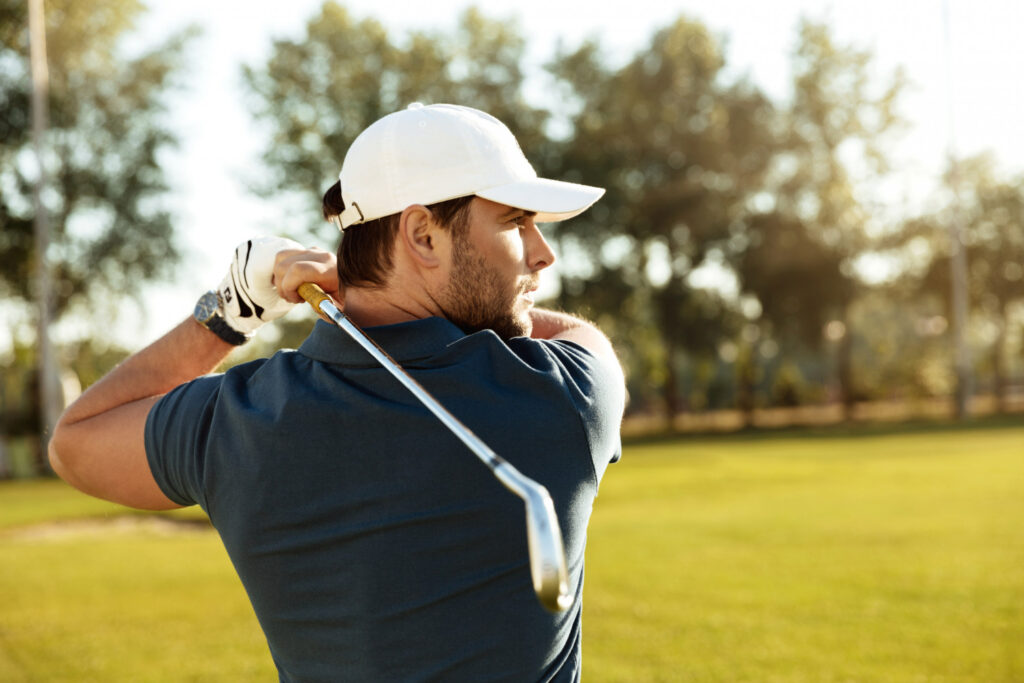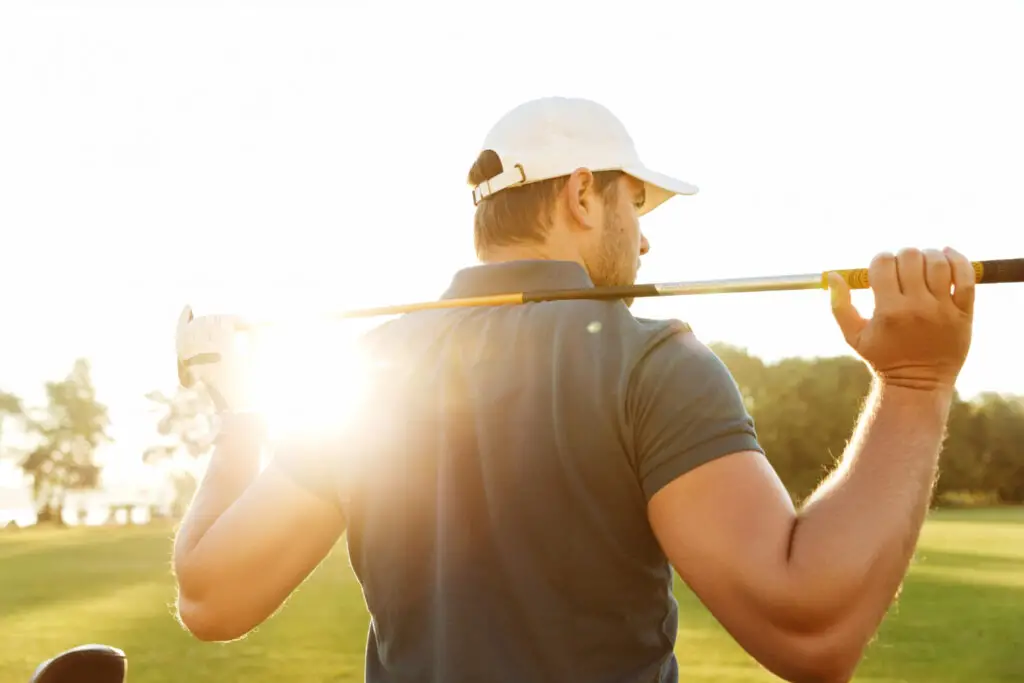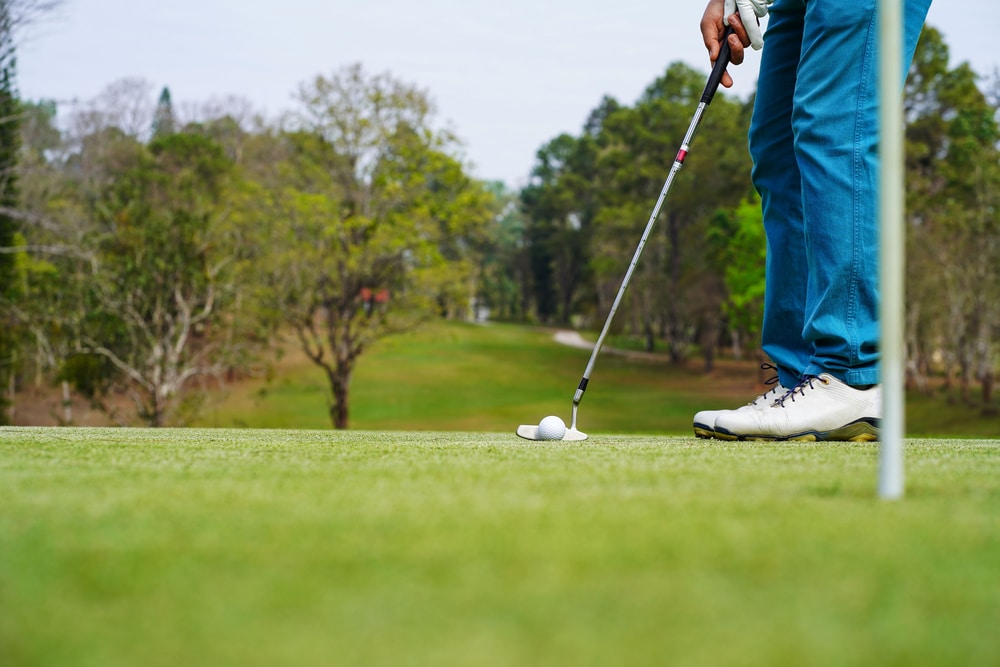Last Updated on November 9, 2023
Golf can be a tricky sport, and there’s no better way to make sure you get the most out of your game than by learning how to hold a golf club correctly. Whether it’s grip basics, positioning your hands, aligning your arms or getting the right amount of pressure on the handle – all these elements are essential for good technique and ultimately improving performance. But don’t worry if this sounds like an intimidating task. We’ll help you navigate through each step in our guide so that even beginners will know exactly what they’re doing when they take their next swing. Let’s start with mastering how to hold a golf club correctly.
Table of Contents:
- Grip Basics
- Positioning Your Hands
- Aligning Your Arms
- The Right Amount of Pressure
- Common Mistakes
- FAQs in Relation to How to Hold a Golf Club Correctly
- Conclusion
Grip Basics
Gripping a golf club is one of the most important aspects of your game. It’s essential to have a good grip in order to hit consistent shots and lower your scores. There are three main types of grips that you can use: overlapping, interlocking, and 10-finger (baseball).
The overlapping grip is the most common type used by professional golfers. In this grip, the little finger on your trailing hand overlaps between the index and middle fingers on your lead hand. This helps create a secure connection between both hands while allowing for more control over the clubface during impact. The downside to this grip is that it can be difficult for some players with smaller hands or shorter fingers to execute properly.

The interlocking grip involves intertwining the index finger from each hand together when gripping the club. This creates an even stronger connection than with an overlap but may not be as comfortable for those with larger hands or longer fingers due to its tightness around them. It also requires more strength in both arms since they must work together throughout every swing motion in order for it to be effective.
Finally, there is the 10-finger (or baseball) grip which has become increasingly popular among amateur players due to its simplicity and comfort level compared to other grips mentioned above. With this method, all ten digits are placed firmly around their respective parts of the handle without any overlap or intertwining involved at all – similar to how you would hold a baseball bat. While it doesn’t provide as much stability as other methods do, it does allow greater freedom of movement throughout each swing, which could help improve accuracy if executed correctly over time with practice drills dedicated specifically towards mastering this particular technique.
Positioning Your Hands
It’s important to make sure that your hands are in the correct place so that you can get maximum distance and control from each swing.
The first step in positioning your hands correctly is to ensure they are placed at an angle of 90 degrees with respect to each other. This means that both thumbs should be pointing straight up towards the sky while both palms face inward towards each other. To check if this angle is correct, hold one hand out flat like a blade and then lay it over top of the other hand as if they were forming an “X” shape. If done properly, there should be no gaps between either thumb or palm – just two solid lines crossing over one another.
Next, make sure that your fingers are evenly spaced along the handle of the club so that all four digits (thumb included) are touching its surface in some way or another without overlapping too much onto one another’s space; think about it as if you were holding a pencil instead of a golf club. Finally, keep your wrists slightly bent but not locked into any particular position – this will help maintain flexibility throughout each swing which leads us to our next point: applying pressure correctly.

When gripping down on a golf club, most people tend to apply too much pressure with their hands which causes them to lose control during their swings due to tension build-up within their arms and shoulders; not ideal. Instead, try using only enough force necessary to keep hold of said object securely yet comfortably – think about it as though you were shaking someone else’s hand rather than squeezing hard enough that they would feel pain afterwards. This technique allows for more fluidity when swinging through impact zones allowing players greater consistency across multiple shots taken from different angles/distances away from target areas such as fairways/greens.
Lastly, avoid making common mistakes such as letting go prematurely before completing entire backswing motions or failing to rotate wrists accordingly after contact has been made with the ball itself. These errors can lead to unwanted results, including slicing off course entirely. With practice, however, these issues can become less frequent over time by simply focusing on proper form and technique during every single stroke taken.
Aligning Your Arms
Proper arm alignment ensures that you have good form and can hit the ball with accuracy and power. It also helps reduce strain on your body as you swing.
The first step in aligning your arms is to make sure they are parallel to each other. This means that both arms should be at the same angle when viewed from above or behind. If one arm is higher than the other, then it will cause an imbalance in your swing, which could lead to poor shots or even injury over time.

Next, check that both elbows are bent at roughly 90 degrees when gripping the club. This will help ensure a consistent grip pressure throughout your swing and allow for maximum control of the clubface during impact with the ball. Your wrists should also be slightly bent so that they don’t lock up while swinging. This will give you more flexibility and power in your shot-making ability.
Finally, ensure that both hands are securely connected on top of the grip while keeping them relaxed but not overly loose. This connection between hands provides stability throughout your swing motion which allows for improved contact with the ball at impact, leading to more accurate shots down range.
It is important to remember that proper arm alignment isn’t just about getting into position before hitting a shot. It’s about maintaining good form throughout every part of your game, from tee off all the way through putting out on the 18th green. With practice and patience, you can develop a consistent setup routine where everything feels natural, so there won’t be any surprises come tournament day.
The Right Amount of Pressure
Gripping a golf club correctly is essential for any golfer, regardless of skill level. It’s important to use just the right amount of pressure when gripping your club, as too much or too little can cause you to lose control and accuracy. Here are some tips on how to ensure that you have the correct grip pressure:
- Start with a light grip – When first starting out, it’s best to start with a light grip on the club. This will help you get used to the feeling of holding and swinging the club without putting too much strain on your hands and arms. You can always increase your grip pressure as needed once you become more comfortable with your swing mechanics.
- Keep it consistent – Once you find what works for you in terms of grip pressure, make sure that it stays consistent throughout each shot and every round of golf that you play. Having an inconsistent grip can lead to inconsistency in ball flight direction and distance which could cost strokes over time if not corrected quickly enough.
- Use both hands equally – Make sure that both hands are applying equal amounts of pressure while gripping the club so that there is no imbalance between them during your swing motion which could affect ball flight trajectory or spin rate off the tee box or green surfaces, respectively.
It is important to find a balance between feeling relaxed and having enough firmness in order to maintain control over the direction of your shots. This will enable you to achieve optimal performance from all areas around course layouts, including fairways and greenside approaches.
Common Mistakes
Unfortunately, many players make common mistakes when gripping their clubs that can lead to poor shots and even injury. Here are some of the most common grip mistakes and how you can avoid them:
Over-gripping
Many beginners tend to grip the club too tightly, which causes tension in their arms and shoulders. This tightness makes it difficult for them to swing freely through impact. To prevent this mistake, try to keep your hands relaxed as you hold the club – think about holding a baby bird instead of squeezing a lemon.
Incorrect Hand Placement
Incorrect hand placement on the handle of the club is another common mistake. It can be either too far up or down from where it should be for maximum control. To ensure proper hand placement, draw two lines on your left palm (for right-handed golfers) – one along your index finger knuckle line and another along your pinky knuckle line – then place those same lines onto the handle to match up perfectly before gripping firmly but not overly tight with both hands at once.
Poor Alignment
It’s also important to make sure that your arms are properly aligned when gripping a golf club. If they aren’t parallel or perpendicular to each other, then you won’t have any consistency in your shots, no matter how hard you practice. The best way to check alignment is by standing directly behind yourself in front of a mirror while holding the club out in front of you; if everything looks straight, then great – otherwise, adjust until everything lines up correctly before taking any swings.
Wrong Amount of Pressure
Lastly, many people don’t realise how much pressure needs to be applied when gripping a golf club – too little will cause loss of control during swings, while too much will tire out muscles quickly, leading to fatigue throughout rounds which could affect accuracy negatively over time. A good rule here is “firm but gentle”, – meaning use enough pressure so that there’s still some give between fingers/palm but not so much that it feels like squeezing something very hard all day long.
FAQs in Relation to How to Hold a Golf Club Correctly
How do you grip a golf club for beginners?
The most common grip used by amateur golfers is the overlapping or Vardon grip. To do this, place your left hand on the club first and wrap your fingers around it so that they overlap with your right hand’s pinky finger. Your thumbs should be pointing down the shaft of the club and slightly towards each other. Then place your right hand on top of your left, matching up the pads in between both palms and wrapping all four fingers around the handle of the club. Make sure to keep pressure evenly distributed throughout both hands as you hold onto it firmly but not too tightly.
What is the best hand grip for golf?
The best hand grip for golf is the overlapping or interlocking grip. This type of grip allows you to have a secure hold on the club and helps maintain control throughout your swing. It also provides more power when hitting shots, as it reduces wrist movement and keeps your hands in sync with each other. To use this grip, place your left pinky finger between the index and middle fingers of your right hand, then wrap both hands around the handle of the club. With practice, you’ll be able to master this technique and hit longer drives with greater accuracy.
Conclusion
When you have the right grip, it helps ensure that your swing is consistent and accurate. With practice and patience, you can master the basics of gripping a golf club in no time. Remember to keep your hands positioned properly on the handle, align your arms with each other, apply just enough pressure without straining yourself and avoid common mistakes like gripping too tightly or using an incorrect hand position. With these tips in mind, you’ll be able to confidently hold a golf club correctly every time.



